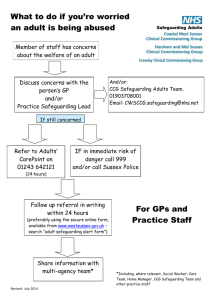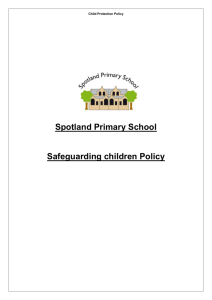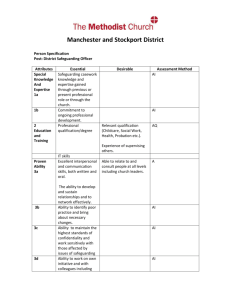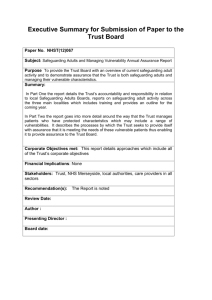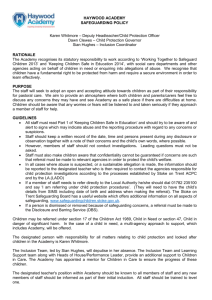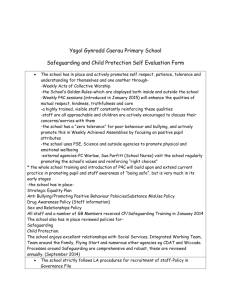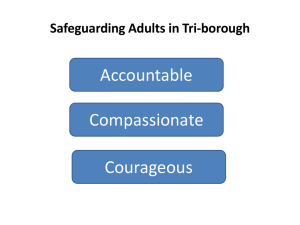Glendene Academy Safeguarding Children and Young People
advertisement
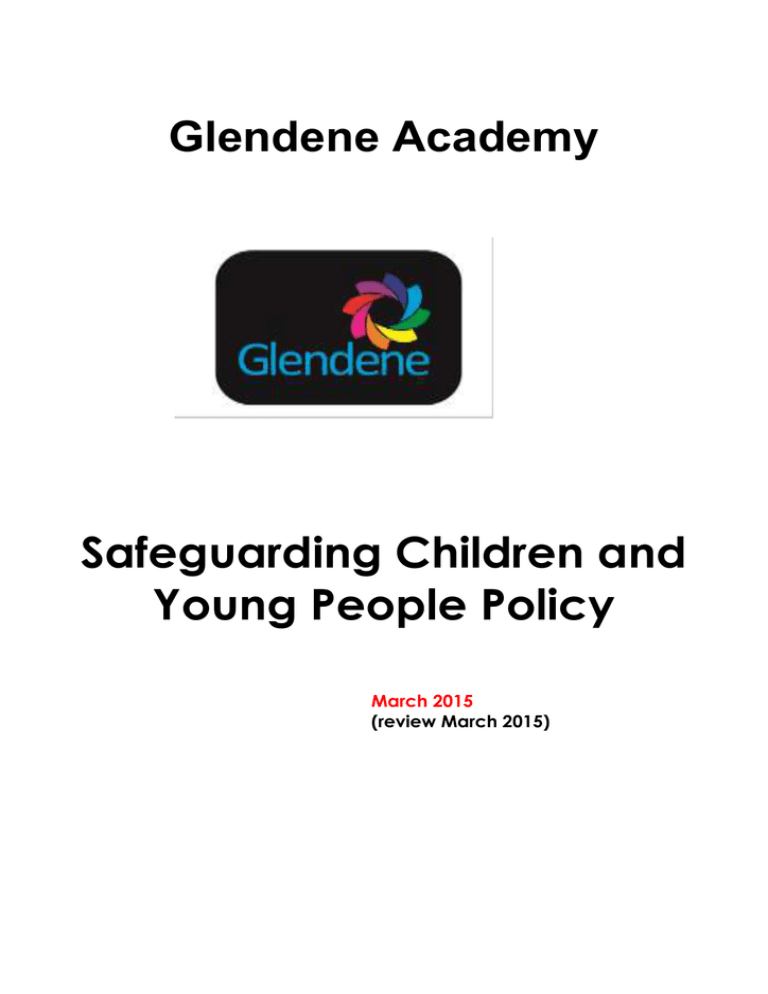
Glendene Academy Safeguarding Children and Young People Policy March 2015 (review March 2015) Rationale: This policy sets out how the Governing Body of Glendene Arts Academy is carrying out its statutory responsibility to safeguard and promote the welfare of children in accordance with ‘Keeping Children safe in Education’, April 2014, ‘Safer recruitment in Education’ 2007 and the Education Act 2002. It should be read alongside Working Together to Safeguard Children 2013. For clarification, Durham Safeguarding classifies Young People as children until they leave school if they have additional needs (including all of those in attendance at a Special School). This means that all students at Glendene Arts Academy regardless of age are classed as children should a referral into First Contact be required. This policy applies to all staff (teaching and non-teaching), governors and volunteers, temporary and supply/visiting staff working in the school. It will be reviewed regularly by the Governing Body. Aims: To ensure that all necessary internal and inter-agency Safeguarding procedures are in place as required To give guidance to staff to ensure best practice To demonstrate the links with other relevant policies to safeguard the general welfare of children and young adults To provide a clear statement of the school’s responsibilities in the event of a concern about the conduct of a member of staff To identify key individuals and their specific role Principles: Glendene Academy recognises its responsibility to protect and safeguard the welfare of the children and young people entrusted to its care by establishing a safe environment in which children can learn and develop. The policy applies to all children and young people whose care and education comes within the remit of this school. The staff and Governing Body of this school are committed to establishing and maintaining an environment where everyone feels secure, are encouraged to talk, and are listened to. We will ensure that children and young people know that there are adults in the school who they can approach if they are worried and that the principles of confidentiality are made clear to children and young people. The school promotes a positive, supportive and secure ethos, giving pupils a sense of being valued. We recognise that because of the day to day contact with children and young people, staff in school are well placed to observe the signs of possible abuse and therefore need to be constantly vigilant. The Academy recognises its responsibility to discuss with Social Care any significant concerns about a child or young person which may indicate physical abuse, emotional abuse, sexual abuse or neglect, in accordance with the Local Safeguarding Children Board child protection procedures and to attend any child protection conferences, initial and review, and core group meetings and child in need conferences that may be called. All staff will receive appropriate training to ensure that these procedures are followed as required. This school also recognises its duty to work with other agencies in protecting children from harm and in responding to concerns about possible abuse, including the Police, Child and Adolescent Mental Health Services, Educational Psychology Service and other agencies/services coming into school to support individual pupils/groups of pupils The Academy’s Safeguarding Children and Young People Policy is made available to parents. Ethos: In support of the ethos of Glendene Academy, the staff and trustees are committed to the following principles: The welfare and well-being of each person is of paramount importance. We respect and value each young person as an individual. We are a listening academy and encourage an environment where children and young people feel free to talk, knowing that they will be listened to. The protection of children and young people from abuse is a whole academy issue and the responsibility therefore of the entire academy community. We will use the academy’s curriculum to resource our children and young people to protect themselves from abuse, both as victims and as potential perpetrators. The Designated Safeguarding Lead The Designated Safeguarding Lead for Child Protection is currently Mr. Mark McNichol, Strategic Manager. The school has identified Vanessa Elcock, Assistant Head, Becky Newbold, Assistant Head and Deborah Darwin as Designated Safeguarding Lead Deputies. The DSL will co-ordinate action on Safeguarding within the school. This includes ensuring that all staff, teaching and non-teaching (including supply staff) know who the Designated Safeguarding Leads are and that they are aware of their individual responsibility to be alert to the signs of abuse and to discuss any concerns with a Designated Member of Staff. Also that they are aware of what happens once a concern has been raised. The DSL will keep a written record of any actions taken as a result of concerns raised. The DSL will ensure that the Academy’s Safeguarding policy is put on the agenda of the Governing Body once a year for discussion, monitoring, review and renewal. The Governing Body authorises the Designated Safeguarding Lead to carry out his/her responsibilities as outlined in ‘Safeguarding Children and Safer Recruitment in Education’, January 2007, recognising the importance of the role and arranging appropriate support and training. The DSL has specific roles and responsibilities (See Appendix 3). Procedures (see Appendix 4 for additional information): Any member of staff who has concerns about the safety or potential abuse of a child must report their concerns to the Designated Safeguarding Lead without delay. This can be done verbally, initially to prevent delays in acting on the information. This concern must then be submitted in writing on the agreed EST3 ‘Confidential Child Protection Concern proforma’ so that all concerns and subsequent actions are documented. In accordance with the Local Safeguarding Children Board procedures, the agreement of the family for an external referral should normally be sought where possible. However, if it is felt that seeking any such agreement would increase the level of significant risk of harm to the child, the matter should be discussed with Social Care and their advice sought. This must not contribute to a delay in making a referral. If, at any point, there is a risk of immediate serious harm to a child a referral should be made to children’s social care immediately. Anybody can make a referral. If the child’s situation does not appear to be improving the staff member with concerns should press for re-consideration. Concerns should always lead to help for the child at some point. The school will work to maintain effective links with relevant agencies and co-operate as appropriate with their enquiries regarding child protection matters including attendance at and reports for Initial Child Protection Case Conferences, core groups/care team meetings and Child Protection Review Conferences. Where a child and family would benefit from co-ordinated support from more than one agency example education, health, housing, police) there should be an inter-agency assessment. These assessments should identify what help the child and family require to prevent needs escalating to a point where intervention would be needed via a statutory assessment under the Children Act 1989. The Early Help Assessment should be undertaken by a lead professional who could be a teacher, special educational needs co-ordinator, General Practitioner (GP), family support worker, and/or health visitor. We will keep detailed chronologies of concerns about children, noting the date, event and action taken, even where there is no need to refer the matter to Social Care immediately. These will be kept separate to the child’s school record. The school will ensure that the relevant social worker or Initial Response team is notified if there is an unexplained absence of more than two days or one day following a week-end, of a pupil who is currently subject to a child protection plan. When discussing concerns in respect of a child who is Looked After by the Local Authority, the child’s named social worker must be informed. Concerns relating to a member of the school staff or other person in a Position of Trust: If suspicions in any way involve a member of staff, the matter needs to be brought to the attention of the Designated Safeguarding Lead immediately who will act in accordance with procedures issued to all schools by the Local Authority Designated Officer (LADO). This guidance is available at www.durham-lscb.org.uk. The DSL will attend any Position of Trust/Strategy Meetings relating to allegations against staff. The Sexual Offences (Amendment) Act 2000 established a criminal offence of the abuse of trust affecting teachers and others who are in a relationship of trust with 16-18 year olds. A relationship of trust is one where a teacher, member of education staff or volunteer is in a position of power or influence over a pupil or student by virtue of the work or nature of the activity being undertaken. The legislation is intended to protect young people in education who are over the age of consent but under 18 years of age. ‘Grooming’ a child or young person under 18 with a view to a future sexual relationship may also be an offence in this context. The principle of equality embedded in the legislation applies irrespective of sexual orientation: neither homosexual nor heterosexual relationships are acceptable within a position of trust. Any concern raised by a parent, child or young person will be listened to and taken seriously. Concerns relating to the Principal: Should the concerns relate to the Principal the matter needs to be brought to the attention of the DSL immediately and advice needs to be sought from the LADO. The Chair of the Trustees must be informed. Concerns out of Academy Hours: During the standard Academy day the DSL or a nominated deputy will always be available on site to deal with any disclosures or concerns. During extra-curricular activities (i.e. after school clubs, residential visits, external hirers of the building etc.) the members of staff/hirers will be given contact details for the DSL or a Deputy who is available to deal with any disclosures or concerns via phone. Concerns raised off site: Should a group be off site during the standard Academy day and a concern or disclosure is made the person concerned should call the Academy and speak to the DSL (or a nominated deputy if they are unavailable) to deal with the disclosures or concern. Individual Risk Assessments for visits must document who will be the nominated Safeguarding Lead for the duration of the trip and how to contact them. Record Keeping: Any member of staff receiving a disclosure of abuse from a child or young person, or noticing signs or symptoms of possible abuse in a child or young person, will make notes as soon as possible (within the hour), writing down as exactly as possible using the child’s own words, what was said or seen, putting the scene into context, and giving the time and location. Dates and times of events should be recorded as accurately as possible, together with a note of when the record was made. All records must be signed and dated clearly. Children will not be asked to make a written statement themselves or to sign any records. All records of a child protection nature (handwritten or typed) will be given to the DSL for safekeeping, including written records of any concerns. Access to any records will be authorised only by the DSL or one of his deputies. All records will be securely held, separate from the main pupil file, and in a secure place. When a child who has had a child protection plan leaves the school and/or transfers to another school, the DSL will inform the child’s new school immediately and discuss with the child’s social worker the transfer of any confidential information the school may hold, retaining a copy of the Chronology for one year. When a child leaves Glendene Academy, their records will be retained for 35 years from the date of closure. Confidentiality Pupils occasionally make personal disclosures, either in class or to individual teachers. Teachers, support staff and visitors may come to possess sensitive information about pupils, some of it about illegal activity. All parties need to be clear about the rules of confidentiality which apply in these circumstances Glendene Academy will strive to ensure that: unconditional confidentiality is never offered to pupils, parents or staff pupils are informed that unconditional confidentiality cannot be offered by staff or visitors information about behaviour likely to cause harm to the pupil or others will be passed on to the appropriate agency in the case of illegal activity, action will be taken in the best interest of the pupil where the teacher believes a child to be at moral or physical risk or in breach of the law, they will ensure pupils are aware of those risks and encourage them to seek support from their parents/carers or other appropriate agencies visitors to the school are made aware of the school’s policy on disclosures and confidentiality and that they abide by this in lessons, ground rules are established which ensure that disclosures are not made publicly and that no pupil is pressurised by another to do so. Information about individuals (pupils, parents, staff and visitors) will be treated with discretion as dictated by the Data Protection Policy. The Principal or Designated Members of Staff will disclose information about a pupil to other members of staff on a ‘need to know’ basis only. All staff must be aware that information a child discloses regarding abuse of themselves or another child must be shared as appropriate and cannot be kept secret. Physical control and restrictive physical intervention: (refer to Behaviour Policy) It is important to allow children to do what they can for themselves, but depending on age and circumstances (i.e. a child who is hurt, who needs instruction in the use of a particular instrument/piece of equipment, safety issues such as the need to prevent a child hurting themselves, running into the road etc.), it may be necessary for some physical contact to take place. Section 93 of the Education and Inspections Act 2006 enables school staff to use ‘reasonable force’ to prevent a pupil from : a) committing any offence ; b) causing personal injury to , or damage to the property of, any person (including the pupil himself ) ; c) prejudicing the maintenance of good order and discipline at the school or among any pupils receiving education at the school, whether during the teaching session or otherwise. We have a core group of staff who are Team Teach trained. They are called upon in extreme circumstances, whenever pupils need to be safely moved to an area where they can calm down and talk to staff. The Academy’s Policy on Physical Restraint of Pupils gives guidance on: when staff may use physical control and restraint who is allowed to use physical control and restraint what forms physical control and restraint may take in particular circumstances what forms of physical control and restraint are not acceptable recording of incidents where physical handling has been used The Policy also makes it clear that corporal punishment is NOT allowed. Safe Touch – Touching Children other than to Restrain Glendene Academy has policy on ‘Safe Touch’ and ‘Intimate Care’ and this includes such points as: assisting in the washing of children who have wet/soiled themselves intimate care risk assessments for certain children with medical needs or disabilities. using physical contact to demonstrate exercises or techniques, for example, in PE, sports coaching, CDT administering First Aid supporting younger children and children with special needs who may need physical prompts or help giving appropriate comfort to a child who is distressed recognising that physical contact is a sensitive issue for some cultural groups acknowledging that physical contact becomes increasingly open to question as children reach and go through adolescence ensuring a consistent approach where staff and pupils are of different genders acknowledging that innocent and well-intentioned physical contact can sometimes be misconstrued The Academy also has a prescribed Moving and Handling policy for children requiring complex or repeated physical handling, with specific training for staff who deal with them. Bullying: Our Anti-Bullying policy is reviewed regularly by the Governing Body. Bullying in whatever form is unacceptable at our school. We believe that pupils have the right to be happy and safe, to be themselves and to enjoy peace of mind. We acknowledge that to allow or condone bullying may lead to consideration under child protection procedures. Racist Incidents: Our Equality Policy is reviewed regularly by the Governing Body. We acknowledge that repeated racist incidents or a single serious incident may lead to consideration under child protection procedures. E-safety (refer to policy ‘E-Safety’): Children and young people may expose themselves to danger, whether knowingly or unknowingly, when using the internet and other technologies. Additionally, some young people may find themselves involved in activities which are inappropriate or possibly illegal. We, as a school, have a major responsibility to educate our pupils; teaching them the appropriate behaviours to enable them to remain both safe and legal when using the internet and related technologies, particularly social networking sites. It is also important to include parents as much as possible in this process given that children often have access to computers at home. With modern technologies come modern concerns such as cyberbullying, sexting, on-line grooming etc. Because of these concerns, Glendene Academy does not allow access to or the use of social networking sites such as Facebook, MSN, Twitter etc. The school cannot accept responsibility for inappropriate behaviours on such sites; that is a parental responsibility. In the event of such behaviour, parents will be encouraged to involve the police. It is appropriate to take photographs of children to capture a curriculum activity or a celebration of school life using school equipment providing we have permission to do so from the parents. Staff must not however use their personal mobile phone, camera (still or moving images) or other devices to take, edit or store images of children from this school. Staff should not communicate with pupils through private email accounts, personal phones or social networking sites, even on educational matters, but must use official email and networking sites sanctioned by the school. Staff should be extremely careful in their personal use of social networking sites and must not discuss school business or any issues relating to pupils. Training and supporting staff to equip them to appropriately recognise, respond to and support children who are vulnerable and may be in need of safeguarding: This academy complies with the advice laid down in ‘Keeping children safe in education’ April 2014 and ‘Safer Recruitment in Education’ 2007 to undertake regular training. Every member of staff, including temporary, supply staff, contracted staff and volunteers, should receive an induction covering signs and symptoms to be aware of, response to disclosures and the need for accurate recording. They will be informed who the Designated Teachers for Child Protection are and what this role entails. Safeguarding responsibilities of all staff will be re-enforced before they start work. All staff will be made aware of the government documents ‘Guidance on Safer Working practice for Adults who Work with Children and Young People’, DCSF and ‘Keeping Children Safe in Education’ 2014. All adults working in the Academy receive regular safeguarding and child protection training. Training for Designated Members of Staff is undertaken every 2 years as recommended in ’Safeguarding and Safer Recruitment in Education’ (2007) and in Keeping Children Safe in Education (2014) Names of attendees at these sessions are recorded in the Safeguarding file along with the Single Central Record. In addition, adults are regularly reminded of key messages in order to maintain heightened awareness of safeguarding and child protection issues. We do this in the following ways: Staff meetings, phase briefings, curriculum workshops, CPD and Safeguarding First Newsletters. The Nominated Governor with responsibility for Child Protection is Miss Vanessa Elcock. Safer Recruitment of staff and volunteers and maintaining appropriate Disclosure and Baring Service checks: The school will ensure that safer recruitment practices are in place and followed in checking the suitability of all staff and volunteers to work with children, including relevant members of the Governing Body. Evidence of these checks (the Single Central Record) will be maintained as required by the current Guidance as outlined in ‘Safeguarding Children and Safer Recruitment in Education’ (January 2007). The school will ensure that all staff and volunteers are aware of the need for maintaining appropriate and professional boundaries in their relationships with pupils and parents. The Trustee’s have agreed that DBS’s will be updated on a 5 year cycle. Staff who’s DBS’s are outside of this time frame will have the tracking number for their DBS and proof of ID added to their Personnel File until such time as a renewed DBS comes in. Appendix 1: Types of abuse and neglect Definition of Abuse: a form of maltreatment of a child. Somebody may abuse or neglect a child by inflicting harm, or by failing to act to prevent harm. They may be abused by an adult or adults or another child or children. Physical abuse: a form of abuse which may involve hitting, shaking, throwing, poisoning, burning or scalding, drowning, suffocating or otherwise causing physical harm to a child. Physical harm may also be caused when a parent or carer fabricates the symptoms of, or deliberately induces, illness in a child. Emotional abuse: the persistent emotional maltreatment of a child such as to cause severe and adverse effects on the child’s emotional development. It may involve conveying to a child that they are worthless or unloved, inadequate, or valued only insofar as they meet the needs of another person. It may include not giving the child opportunities to express their views, deliberately silencing them or ‘making fun’ of what they say or how they communicate. It may feature age or developmentally inappropriate expectations being imposed on children. These may include interactions that are beyond a child’s developmental capability as well as overprotection and limitation of exploration and learning, or preventing the child participating in normal social interaction. It may involve seeing or hearing the ill-treatment of another. It may involve serious bullying (including cyberbullying), causing children frequently to feel frightened or in danger, or the exploitation or corruption of children. Some level of emotional abuse is involved in all types of maltreatment of a child, although it may occur alone. Sexual abuse: involves forcing or enticing a child or young person to take part in sexual activities, not necessarily involving a high level of violence, whether or not the child is aware of what is happening. The activities may involve physical contact, including assault by penetration (for example rape or oral sex) or non-penetrative acts such as masturbation, kissing, rubbing and touching outside of clothing. They may also include non-contact activities, such as involving children in looking at, or in the production of, sexual images, watching sexual activities, encouraging children to behave in sexually inappropriate ways, or grooming a child in preparation for abuse (including via the internet). Sexual abuse is not solely perpetrated by adult males. Women can also commit acts of sexual abuse, as can other children. Neglect: the persistent failure to meet a child’s basic physical and/or psychological needs, likely to result in the serious impairment of the child’s health or development. Neglect may occur during pregnancy as a result of maternal substance abuse. Once a child is born, neglect may involve a parent or carer failing to: provide adequate food, clothing and shelter (including exclusion from home or abandonment); protect a child from physical and emotional harm or danger; ensure adequate supervision (including the use of inadequate care-givers); or ensure access to appropriate medical care or treatment. It may also include neglect of, or unresponsiveness to, a child’s basic emotional needs. Appendix 2: Specific safeguarding issues Expert and professional organisations are best placed to provide up-to-date guidance and practical support on specific safeguarding issues. For example NSPCC offers information for schools and colleges on the TES website and also on its own website www.nspcc.org.uk Schools and colleges can also access broad government guidance on the issues listed below via the GOV.UK website: child sexual exploitation (CSE) bullying including cyberbullying domestic violence drugs fabricated or induced illness faith abuse female genital mutilation (FGM) forced marriage gangs and youth violence gender-based violence/violence against women and girls (VAWG) mental health private fostering radicalisation sexting teenage relationship abuse trafficking. Appendix 3: Roles and Responsibilities of the Designated Safeguarding Lead Training Roles and Responsibilities In line with Durham LSCB (R & R Section 2) Roles and Responsibilities In line with Keeping Children Safe in Education (2014; Annex B) Designated member of staff with responsibility for Child Protection Designated Deputy with responsibility for Child Protection Attend relevant 2 yearly training in Safeguarding (Durham LSCB Training) Attend relevant 2 yearly training in Safeguarding (Safeguarding First Ltd DSL Briefings) Responsible for arranging Safeguarding Training for all staff and Governors Responsible for maintaining records in relation to Staff and Governor Safeguarding Training Understand the assessment process for providing early help and Intervention (for example through locally agreed common and shared assessment processes such as early help assessments) Have a working knowledge of how local authorities conduct a child protection case conference and a child protection review conference and be able to attend and contribute to these effectively when required to do so Ensure each member of staff has access to and understands the school’s child protection policy and procedures (especially new and part time staff) Be alert to the specific needs of children in need*, those with special educational needs and young carers. Obtain access to resources and attend any relevant or refresher training courses Encourage a culture of listening to children and taking account of their wishes and feelings, among all staff, in any measures the school or college may put in place to protect them Designated Safeguarding Lead/Deputy with Responsibility Mark Vanessa Becky Deborah McNichol Elcock Newbold Darwin x x x x x x x x x x x x x x x x x x x x x x x x x x x x x x x x x x x x Managing Referrals Roles and Responsibilities In line with Durham LSCB (R & R Section 2) Roles and Responsibilities In line with Keeping Children Safe in Education (2014; Annex B) Refer child protection concerns into Children’s Care Refer cases of concern to the local authority designated officer (LADO) for child protection concerns (all cases which concern a staff member) Refer all cases in to the Disclosure and Barring Service (cases where a person is dismissed or left due to risk/harm to a child) Refer cases in to Police (cases where a crime may have been committed). Liaise with the head teacher or principal to inform him or her of issues especially ongoing enquiries under section 47 of the Children Act 1989 and police investigations Be able to keep detailed, accurate, secure written records of child protection concerns and referrals Produce internal child protection procedures for all staff (including volunteers, governors and visitors) Ensure all Child Protection procedures are freely available to all staff (including volunteers, governors and visitors) Ensure that an induction process is in place for new and temporary staff to ensure they are familiar with protection responsibilities (including secretarial staff, midday supervisors, caretakers, volunteers, etc.) Keep all staff updated with current procedures and changes Ensure all Child Protection procedures are freely available to parents/carers and pupils Act as a source of support, advice and expertise to staff on matters of safety and safeguarding when deciding whether to make a referral by liaising with relevant agencies Designated Safeguarding Lead/Deputy with Responsibility Mark Vanessa Becky Deborah McNichol Elcock Newbold Darwin x x x x x x x x x x x x x x x x x x x x x Raising Awareness Roles and Responsibilities In line with Durham LSCB (R & R Section 2) Roles and Responsibilities In line with Keeping Children Safe in Education (2014; Annex B) The designated safeguarding lead should ensure the school or college’s policies are known and used appropriately Ensure the school or college’s child protection policy is reviewed annually and the procedures and implementation are updated and reviewed regularly, and work with governing bodies or proprietors regarding this Ensure the child protection policy is available publicly and parents are aware of the fact that referrals about suspected abuse or neglect may be made and the role of the school or college in this Link with the local LSCB to make sure staff are aware of training opportunities and the latest local policies on safeguarding 2.3 Inform Children’s Care of proposed or actual change of school 2.3 Ensure complete records are sent safely to the receiving school or college, whether a child changes as a natural progression or for any other reason (retaining a copy of the chronology for one full academic year). 2.3 Monitor attendance and development of children whose names are currently on the Child Protection List 2.3 Ensure that all relevant information about a child is disseminated appropriately to staff within the school 2.3 Ensure attendance at relevant review meetings Ensure minutes of TAC, TAF, CIN and CP meetings are maintained on the individual case file Act as a source of support, advice and expertise to all staff on matters of safety and safeguarding Act as a source of support, advice and expertise to all Governors on matters of safety and safeguarding Designated Safeguarding Lead/Deputy with Responsibility Mark Vanessa Becky Deborah McNichol Elcock Newbold Darwin x x x x x x x x x x x x x x x x x x * Section 17(10) Children Act 1989: those unlikely to achieve a reasonable standard of health and development without local authority services, those whose health and development is likely to be significantly impaired without the provision of such services, or disabled children. Appendix 4: Referral Process (KCSIE, DfE, 2014). Appendix 5: Tabled Changes Academic Year Designated Safeguarding Lead Named Deputies 2013-2014 Craig Platt Acting Academy Leader Vanessa Elcock, Acting Deputy Academy Lead Nominated Safeguarding Governor Mrs. E. Coxon, Mr. M. McNichol Strategic Manager 2014 - Mark McNichol Strategic Manager Mrs. A. Walker Vanessa Elcock Head of Primary Becky Newbold Head of Secondary Deborah Darwin Review Date Changes made November 2014 March 2015 Policy Review in light of changes re: Keeping Children Safe in Education Document (April 2014). Designated Lead and Deputies reassigned. Clarification around allegations against the Head others in a position of trust Minor formatting changes Update to remove PRICE and add in TeamTeach Added in information for disclosures during extra-curricular or offsite activities Clarification regarding age of Children within Durham LA. Update around 5 year cycle for DBS renewals. Ratification by Governing Body

